

These stained glass windows are in the four bays between the north porch and the north transept of Bristol Cathedral. Each window is divided into two rows of four frames; the inner frames on each row show uniformed members of various organisations, while the outer frames each have a badge relevant to the figures.
Each pair of figures in the pictures below is divided by stonework which doesn't show up very well.
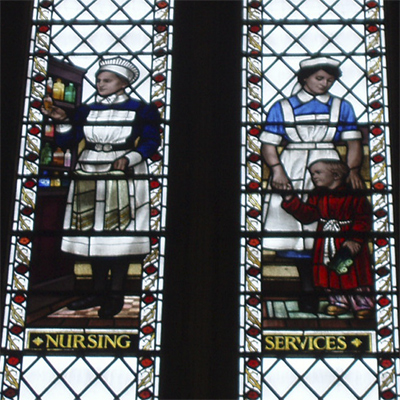 Nursing Services
Nursing Services
A ward sister examining a small bottle and holding a bowl on a tray, and a nurse comforting a young child.
The side panels show the badge of the General Nursing Council for England and Wales on the left and a heraldic shield (three gold stars and a sun on a blue field) on the right. The GNC was created in 1919 and maintained the first register of nurses.
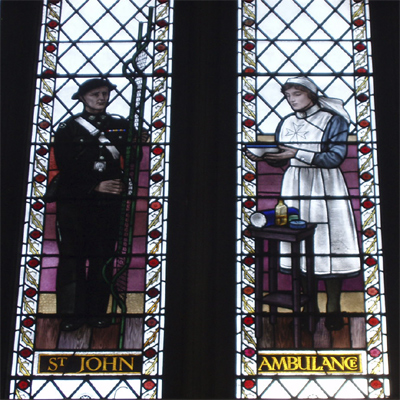 St. John Ambulance
St. John Ambulance
A St John Ambulanceman in the Ambulance's standard dark blue uniform worn with a dark blue steel helmet stands with a metal stretcher, and female nurse in St John's nursing uniform holds a bowl over a bedside table. Both appear to be indoors. During the war the St John Ambulance and the Red Cross formed the Joint War Organisation to meet medical and welfare needs in the UK and abroad.
Side panels show two St John Ambulance badges - on the left a cap badge, and on the right a Badge of Gratitude to be awarded to a person "who has rendered good service" to the SJA.
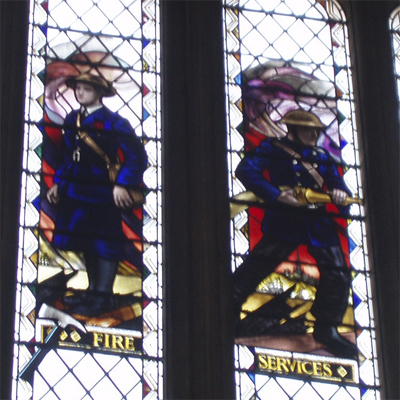 Fire Services
Fire Services
Female and male fire fighters, in their blue uniforms with a standard army-issue steel helmet. The steel helmet was favoured by the authorities as it could be boiled after mustard gas attacks, even though firefighters felt it put them at risk of electrocution.
Side panels show the badges of the AFS (Auxillary Fire Service) and the NFS (National Fire Service). The AFS was formed in 1938 to provide extra fire fighting capability for the expected war. In August 1941 the AFS was combined with the existing city fire brigades to form the National Fire Service, which is the basis of today's fire services.
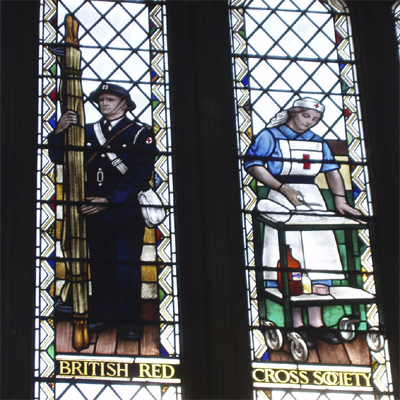 British Red Cross Society
British Red Cross Society
A blue-uniformed and helmeted ambulance standing with a folded canvas stretcher, and a nurse cutting bandages on a hospital trolley. The British Red Cross was created in 1905, based on the earlier British National Society for Aid to the Sick and Wounded in War.
Side panels show the badges of the British Red Cross Society and the Mobile VAD (Voluntary Aid Detachment). The VAD was created as a nursing corps during the First World War; the Second World War Mobile VADs were expected to move around the country or overseas as directed, and had to serve for three years.
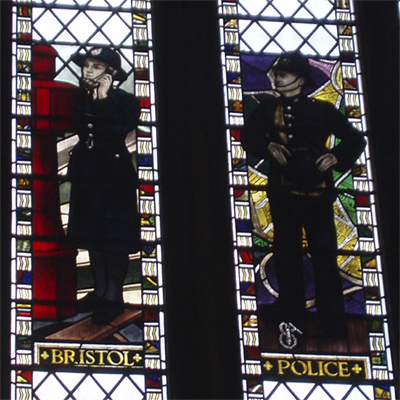 Bristol Police
Bristol Police
A woman police constable in a dark blue uniform including a wide brimmed hat (which looks a bit like a steel helmet and was replaced by a peaked cap after the war) stands using a emergency phone, and a male police constable wearing a traditional bobbie's helmet but holding a steel helmet over his gas mask case.
The side panels show the badge of the Bristol Constabulary and a police badge with the number 40 in the centre of an eight pointed star.
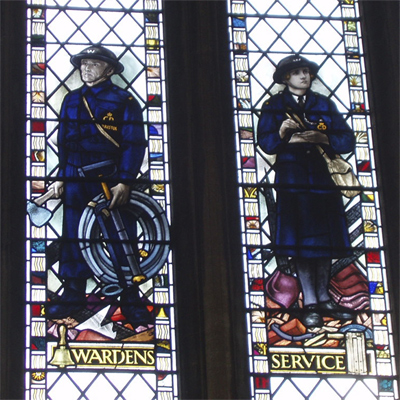 Wardens Service
Wardens Service
Two Civil Defence workers, both in blue serge and wearing steel helmets marked with a white W, apparently standing in a bombed out building.
Side panels show the badges of the ARP (Air Raid Precautions) and the CD (Civil Defence) services.
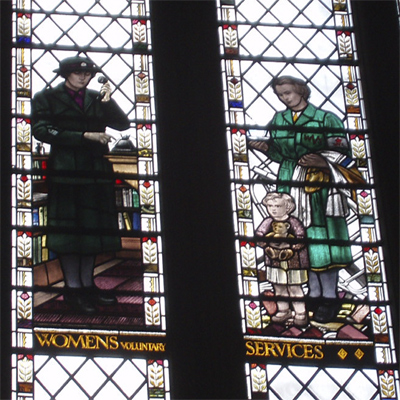 Womens Voluntary Services
Womens Voluntary Services
WVS woman in a bottle green uniform (designed by Norman Hartnell, the Queen's couturier) in an office with a telephone, and a WVS woman in a light green overall with a small child in a wrecked house. At different times during the war the Womens Voluntary Service organised the evacuation of children, ran nurseries, distributed ration books, and staffed hostels, communal eating areas, mobile canteens and rest centres for bombed out families.
Side panels show the badges of the WVS Civil Defence and the WVS Housewives Section.
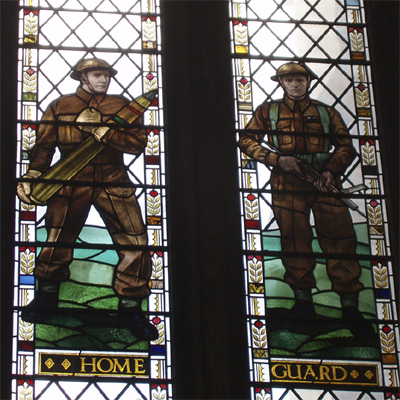 Home Guard
Home Guard
Two men in battle dress, one clutching an anti-aircraft shell, the other with a Sten gun. There were nineteen Home Guard battalions in Gloucestershire, of which nine (9th to 16th, and the 18th) were based in Bristol. Five troops from the 71st Gloucestershire Heavy Anti Aircraft Regiment were attached to Bristol-based Home Guard units, and there were also five Home Guard manned batteries of Z-guns, which launched unguided anti-aircraft rockets.
On the left is a blue square badge with a red bow and arrow pointing upwards, presumably the insignia of the 71st Gloucestershire Home Guard Heavy Anti-Aircraft Regiment; on the right the arms of the city of Gloucester. Both badges are surmounted by the sphinx badge of the Gloucestershire Regiment; all the Gloustershire Home Guard battalions wore this cap badge (except for the 15th who wore Post Office badges).
Return to Mr Monkey visits Bristol Cathedral
Copyright Rik Shepherd and Mr Monkey.